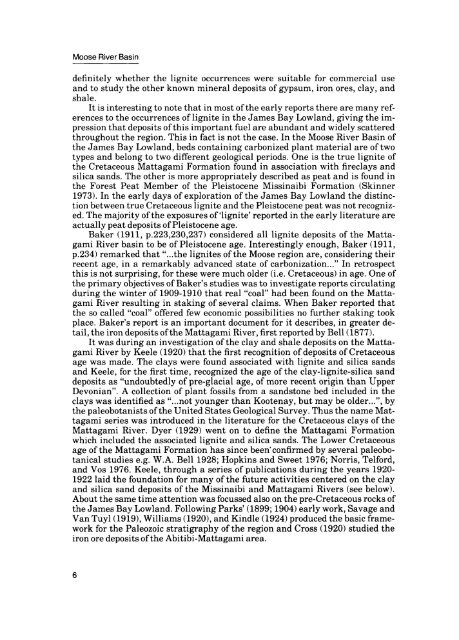Moose River Basin: geology and mineral potential - Geology Ontario
Moose River Basin: geology and mineral potential - Geology Ontario
Moose River Basin: geology and mineral potential - Geology Ontario
Create successful ePaper yourself
Turn your PDF publications into a flip-book with our unique Google optimized e-Paper software.
<strong>Moose</strong> <strong>River</strong> <strong>Basin</strong><br />
definitely whether the lignite occurrences were suitable for commercial use<br />
<strong>and</strong> to study the other known <strong>mineral</strong> deposits of gypsum, iron ores, clay, <strong>and</strong><br />
shale.<br />
It is interesting to note that in most of the early reports there are many ref<br />
erences to the occurrences of lignite in the James Bay Lowl<strong>and</strong>, giving the im<br />
pression that deposits of this important fuel are abundant <strong>and</strong> widely scattered<br />
throughout the region. This in fact is not the case. In the <strong>Moose</strong> <strong>River</strong> <strong>Basin</strong> of<br />
the James Bay Lowl<strong>and</strong>, beds containing carbonized plant material are of two<br />
types <strong>and</strong> belong to two different geological periods. One is the true lignite of<br />
the Cretaceous Mattagami Formation found in association with fireclays <strong>and</strong><br />
silica s<strong>and</strong>s. The other is more appropriately described as peat <strong>and</strong> is found in<br />
the Forest Peat Member of the Pleistocene Missinaibi Formation (Skinner<br />
1973). In the early days of exploration of the James Bay Lowl<strong>and</strong> the distinc<br />
tion between true Cretaceous lignite <strong>and</strong> the Pleistocene peat was not recogniz<br />
ed. The majority of the exposures of'lignite' reported in the early literature are<br />
actually peat deposits of Pleistocene age.<br />
Baker (1911, p.223,230,237) considered all lignite deposits of the Matta<br />
gami <strong>River</strong> basin to be of Pleistocene age. Interestingly enough, Baker (1911,<br />
p.234) remarked that "...the lignites of the <strong>Moose</strong> region are, considering their<br />
recent age, in a remarkably advanced state of carbonization..." In retrospect<br />
this is not surprising, for these were much older (i.e. Cretaceous) in age. One of<br />
the primary objectives of Baker's studies was to investigate reports circulating<br />
during the winter of 1909-1910 that real "coal" had been found on the Matta<br />
gami <strong>River</strong> resulting in staking of several claims. When Baker reported that<br />
the so called "coal" offered few economic possibilities no further staking took<br />
place. Baker's report is an important document for it describes, in greater de<br />
tail, the iron deposits of the Mattagami <strong>River</strong>, first reported by Bell (1877).<br />
It was during an investigation of the clay <strong>and</strong> shale deposits on the Matta<br />
gami <strong>River</strong> by Keele (1920) that the first recognition of deposits of Cretaceous<br />
age was made. The clays were found associated with lignite <strong>and</strong> silica s<strong>and</strong>s<br />
<strong>and</strong> Keele, for the first time, recognized the age of the clay-lignite-silica s<strong>and</strong><br />
deposits as "undoubtedly of pre-glacial age, of more recent origin than Upper<br />
Devonian". A collection of plant fossils from a s<strong>and</strong>stone bed included in the<br />
clays was identified as "...not younger than Kootenay, but may be older...", by<br />
the paleobotanists of the United States Geological Survey. Thus the name Mat<br />
tagami series was introduced in the literature for the Cretaceous clays of the<br />
Mattagami <strong>River</strong>. Dyer (1929) went on to define the Mattagami Formation<br />
which included the associated lignite <strong>and</strong> silica s<strong>and</strong>s. The Lower Cretaceous<br />
age of the Mattagami Formation has since been' confirmed by several paleobotanical<br />
studies e.g. W.A. Bell 1928; Hopkins <strong>and</strong> Sweet 1976; Norris, Telford,<br />
<strong>and</strong> Vos 1976. Keele, through a series of publications during the years 1920-<br />
1922 laid the foundation for many of the future activities centered on the clay<br />
<strong>and</strong> silica s<strong>and</strong> deposits of the Missinaibi <strong>and</strong> Mattagami <strong>River</strong>s (see below).<br />
About the same time attention was focussed also on the pre-Cretaceous rocks of<br />
the James Bay Lowl<strong>and</strong>. Following Parks' (1899; 1904) early work, Savage <strong>and</strong><br />
Van Tuyl (1919), Williams (1920), <strong>and</strong> Kindle (1924) produced the basic frame<br />
work for the Paleozoic stratigraphy of the region <strong>and</strong> Cross (1920) studied the<br />
iron ore deposits of the Abitibi-Mattagami area.

















